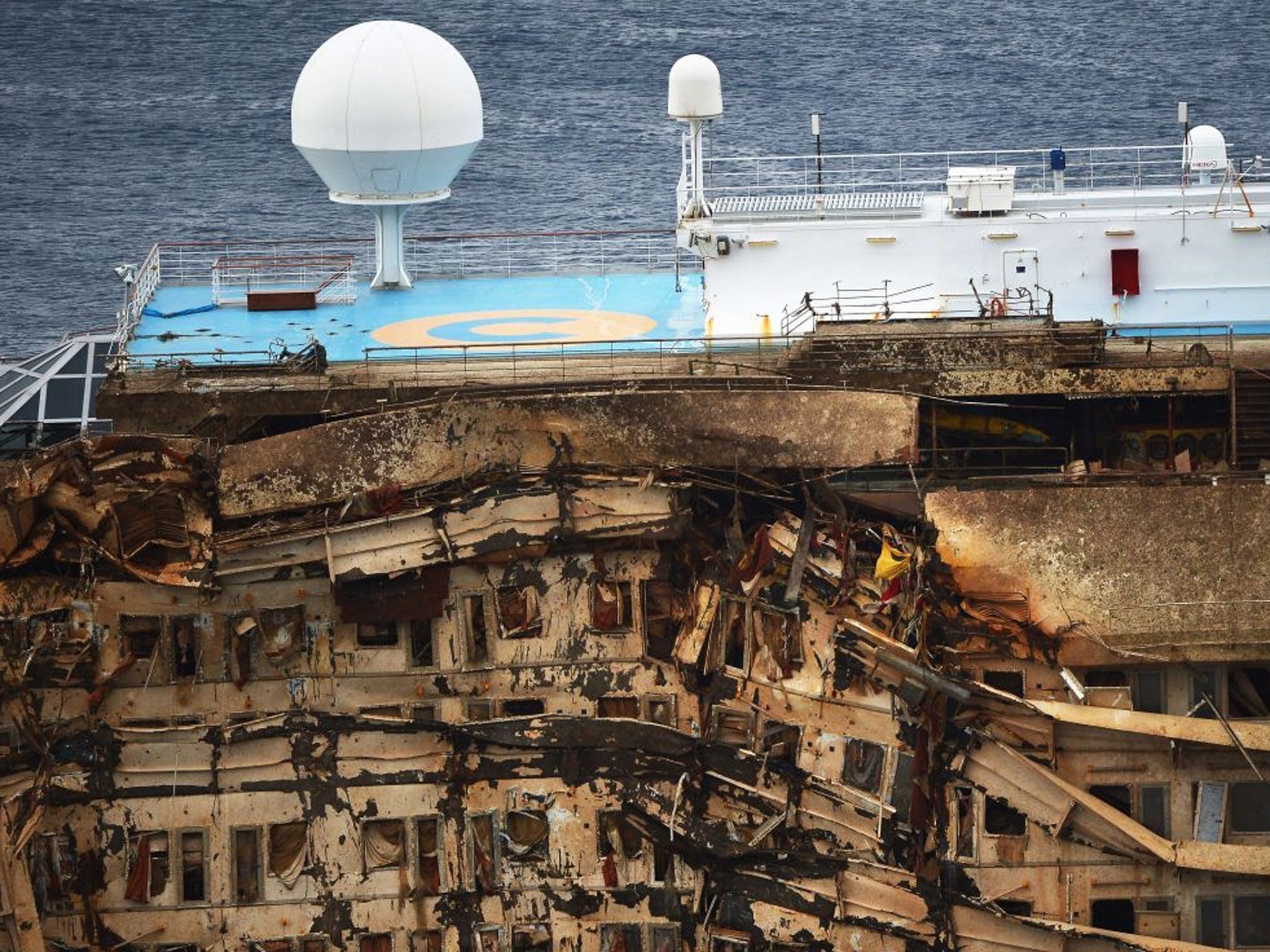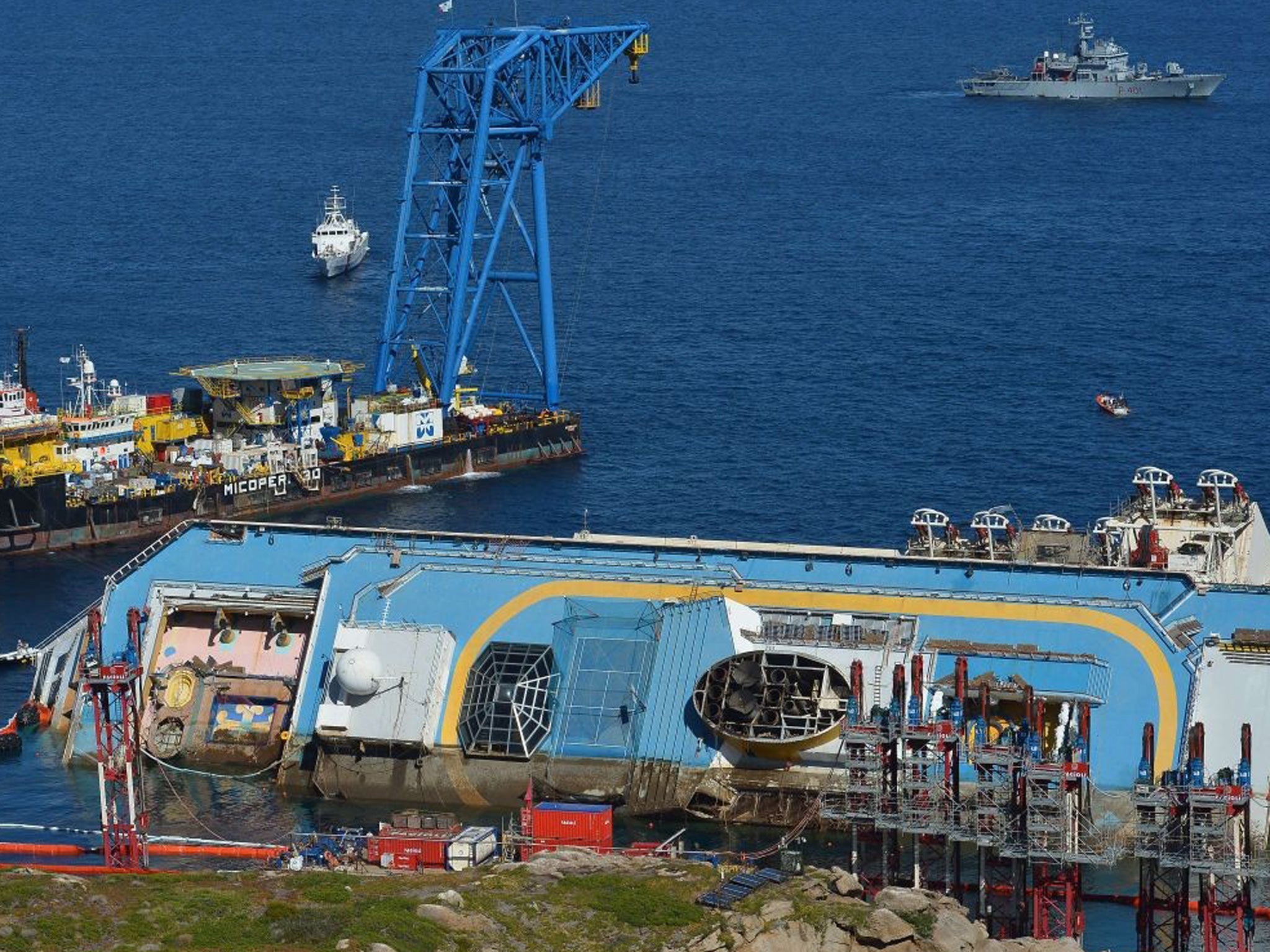Costa Concordia salvaged: Ship pulled upright as damage from tragic capsize emerges
A 19-hour salvage operation pulls wrecked liner upright using pulleys, cables and giant water-filled tanks
Your support helps us to tell the story
From reproductive rights to climate change to Big Tech, The Independent is on the ground when the story is developing. Whether it's investigating the financials of Elon Musk's pro-Trump PAC or producing our latest documentary, 'The A Word', which shines a light on the American women fighting for reproductive rights, we know how important it is to parse out the facts from the messaging.
At such a critical moment in US history, we need reporters on the ground. Your donation allows us to keep sending journalists to speak to both sides of the story.
The Independent is trusted by Americans across the entire political spectrum. And unlike many other quality news outlets, we choose not to lock Americans out of our reporting and analysis with paywalls. We believe quality journalism should be available to everyone, paid for by those who can afford it.
Your support makes all the difference.Engineers in Italy have successfully pulled the Costa Concordia cruise liner completely upright during a complicated, 19-hour operation to wrench it from its side where it capsized last year off Tuscany, an unprecedented feat that sets the stage for it to be towed away next year.
The submerged side of the Concordia suffered significant damage after 20 months bearing the weight of the ship and the operation to right it, officials said.
The Costa Concordia capsized in January 2012, killing 32 people.
That damage must be repaired to stabilize the ship so it can be towed and turned into scrap.
Shortly after 4am local time, a foghorn wailed off Giglio Island and the head of Italy's Civil Protection agency, Franco Gabrielli, announced that the ship had reached vertical and that the operation to rotate it — known in nautical terms as parbuckling—was complete.
"We completed the parbuckling operation a few minutes ago the way we thought it would happen and the way we hoped it would happen," said Franco Porcellacchia, project manager for the Concordia's owner, Costa Crociere SpA.
He added that no environmental spill had been detected so far.
An hour later Nick Sloane, the South African chief salvage master, received a hero's welcome as he came ashore from the barge that had served as the floating command control room for the operation.
"It was a struggle, a bit of a roller coaster. But for the whole team it was fantastic," Mr Sloane said.
The Concordia slammed into a reef off Giglio Island on 13 January 2012, after the captain brought it too close to shore. The cruise ship drifted, listed and capsized just off the island's port. Two of the 32 bodies were never recovered.
The operation to right it had been expected to take no more than 12 hours, but dragged on after some initial delays and maintenance on the vast system of steel cables, pulleys and counterweights that were used to roll the 115,000-ton, half-submerged carcass of steel upright.
More than 50 large chains and winches were used to break the ship - twice as heavy as the Titanic - away from the reef.
The rotation's final phase went remarkably fast as gravity began to kick in and pull the ship toward its normal vertical position.
Parbuckling is a standard operation to right capsized ships. But never before had it been used on such a huge cruise liner.
The Concordia is expected to be floated away from Giglio in the spring and turned into scrap metal. The aim was to right it intact, to prevent the leakage of potentially toxic waste into the pristine waters around Giglio, which is located in a marine sanctuary.

An initial inspection of the starboard side, covered in brown slime from its 20 months underwater, perched on a jagged reef, indicated serious damage that must be fixed in the coming weeks and months, according to Mr Sloane.
The damage was caused by the capsizing, bearing the ship's weight and the operation to rotate the ship, he added.
The starboard side of the ship, which was raised 65 degrees in the operation, must be stabilised to enable crews to attach empty tanks on the side that will later be used to help float the vessel away. Such tanks were affixed to the exposed, port side of the ship and were filled with water in the later phases of the rotation to help pull the port side down.

The ship must be made strong enough to withstand the winter storm season, when high seas and strong winds are likely buffet the 300-metre (1,000ft) long liner.
"I think the whole team is proud of what they achieved," Mr Sloane said as he was mobbed by well-wishers and television crews, still wearing an orange life vest around his neck and carrying a South African flag in his hand, given to him by his wife.
Helping the Concordia to weather the winter and stabilize it is an artificial platform on the seabed that was constructed to support the ship's flat keel.
"The ship is resting on its platform," Mr Gabrielli said.
About an hour before the rotation was complete, observers said the ship seemed to suddenly settle down upon its new perch, with a clear brown-green line of algae drawn across its front delineating the half of the liner that had been underwater and the half that was exposed.

Mayor Sergio Ortelli said the island felt a wave of relief as soon as the Concordia was freed from the reef in the initial hours of the operation. But he said there was also the realization that two bodies still have yet to be found, with a fresh search to be launched now that the ship is upright.
"While there is happiness today, there is no triumphalism," he told The Associated Press.
The Concordia's captain is on trial for alleged manslaughter, causing a shipwreck and abandoning the ship during the chaotic and delayed evacuation. Capt. Francesco Schettino claims the reef wasn't on the nautical charts for the liner's weeklong Mediterranean cruise. Five other Costa employees were convicted of manslaughter in a plea bargain and were sentenced to less than three years apiece.
Costa is a division of Miami-based Carnival Corp., the world's largest cruise company.
Additional reporting by AP
Join our commenting forum
Join thought-provoking conversations, follow other Independent readers and see their replies
Comments